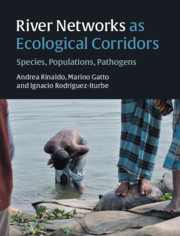River Networks as Ecological Corridors Species, Populations, Pathogens
Langue : Anglais
Auteurs : Rinaldo Andrea, Gatto Marino, Rodriguez-Iturbe Ignacio

An overview of state-of-the-art research on how river environments impact biodiversity, species invasions, population dynamics, and the spread of waterborne disease.
River networks are critically important ecosystems. This interdisciplinary book provides an integrated ecohydrological framework blending laboratory, field, and theoretical evidence that changes our understanding of river networks as ecological corridors. It describes how the physical structure of the river environment impacts biodiversity, species invasions, population dynamics, and the spread of waterborne disease. State-of-the-art research on the ecological roles of the structure of river networks is summarized, including important studies on the spread and control of waterborne diseases, biodiversity loss due to water resource management, and invasions by non-native species. Practical implications of this research are illustrated with numerous examples throughout. This is an invaluable go-to reference for graduate students and researchers interested in river ecology and hydrology, and the links between the two. Describing new related research on spatially-explicit modeling of the spread of waterborne disease, this book will also be of great interest to epidemiologists and public health managers.
Preface; Acknowledgments; 1. Introduction; 2. Species; 3. Populations; 4. Waterborne disease; 5. Afterthoughts and outlook; Appendix A. Stability of dynamical systems and bifurcation analysis; Appendix B. Optimal channel networks and geomorphological statistical mechanics; Appendix C. Computational tools for waterborne disease spread; References; Index.
Andrea Rinaldo is Professor and Director of the Laboratory of Ecohydrology at the École Polytechnique Fédérale de Lausanne (EPFL) and Professor in the Civil, Environmental and Architectural Engineering department at the University of Padua. His research focuses on water controls on biota, for which he has received international recognition including membership of the US National Academies of Sciences and Engineering, the American Academy of Arts and Sciences, and the Royal Swedish Academy of Sciences. He is the co-author of Fractal River Basins: Chance and Self-Organization (with Ignacio Rodríguez-Iturbe, Cambridge, 1997).
Marino Gatto is Professor of Ecology at Politecnico di Milano. His research focuses on ecological modelling, fish population dynamics and management, and parasite ecology. He was President of the Italian Society of Ecology from 2003 to 2006, and is a member of Istituto Lombardo Accademia di Scienze e Lettere and Istituto Veneto di Scienze, Lettere ed Arti.
Ignacio Rodríguez-Iturbe is Distinguished University Professor at Texas A&M University and J. S. McDonnell Distinguished University Professor (Emeritus) at Princeton University, New Jersey. He is a member of the US National Academies of Sciences and Engineering, the American Academy of Arts and Sciences, and the Vatican Academy of Sciences. He has been awarded the Stockholm Water Prize and the Bowie, Horton and Macelwane Medals from the American Geophysical Union. He is the co-author of Fractal River Basins: Chance and Self-Organization (with Andrea Rinaldo, Cambridge, 1997) and Ecohydrology of Water-Controlled Ecosystems: Soil Moisture and Plant Dynamics (with Amilcare Porporato, Cambridge, 2005).
Marino Gatto is Professor of Ecology at Politecnico di Milano. His research focuses on ecological modelling, fish population dynamics and management, and parasite ecology. He was President of the Italian Society of Ecology from 2003 to 2006, and is a member of Istituto Lombardo Accademia di Scienze e Lettere and Istituto Veneto di Scienze, Lettere ed Arti.
Ignacio Rodríguez-Iturbe is Distinguished University Professor at Texas A&M University and J. S. McDonnell Distinguished University Professor (Emeritus) at Princeton University, New Jersey. He is a member of the US National Academies of Sciences and Engineering, the American Academy of Arts and Sciences, and the Vatican Academy of Sciences. He has been awarded the Stockholm Water Prize and the Bowie, Horton and Macelwane Medals from the American Geophysical Union. He is the co-author of Fractal River Basins: Chance and Self-Organization (with Andrea Rinaldo, Cambridge, 1997) and Ecohydrology of Water-Controlled Ecosystems: Soil Moisture and Plant Dynamics (with Amilcare Porporato, Cambridge, 2005).
Date de parution : 10-2020
Ouvrage de 454 p.
18.3x26 cm
Thème de River Networks as Ecological Corridors :
© 2024 LAVOISIER S.A.S.
